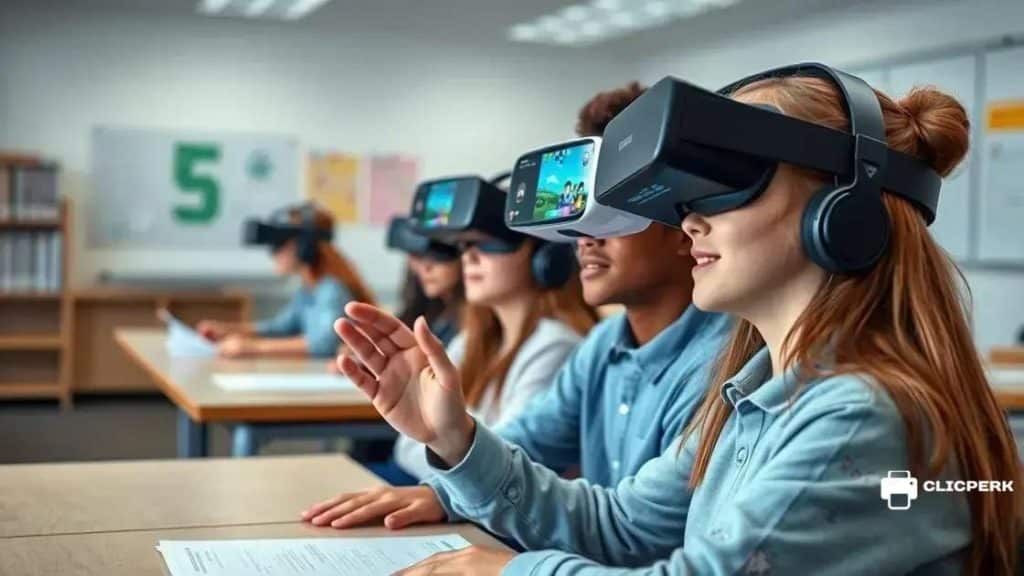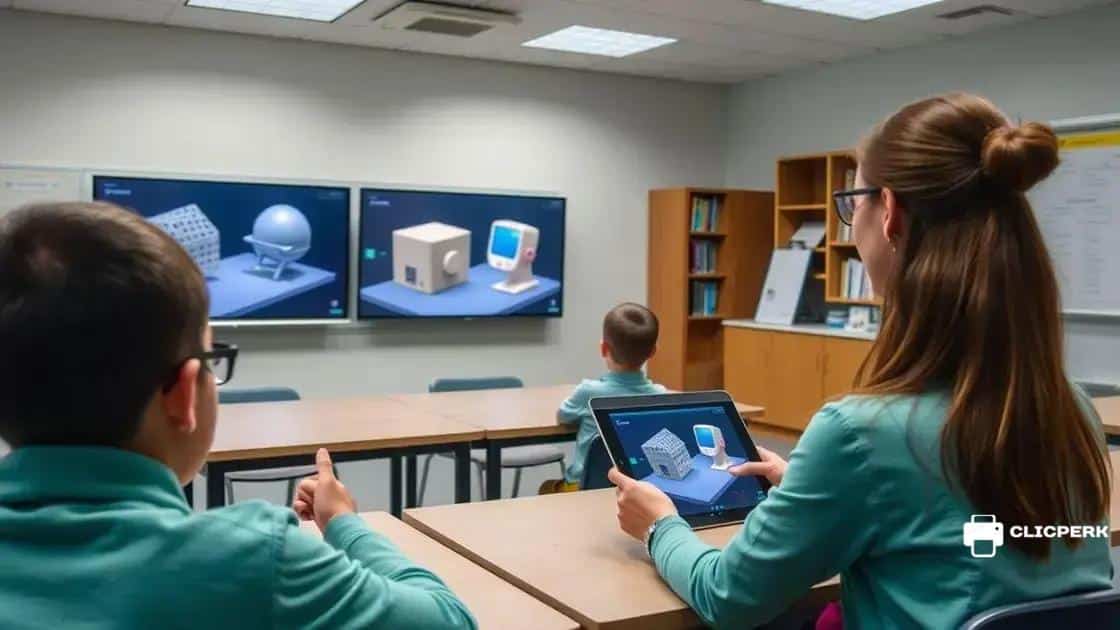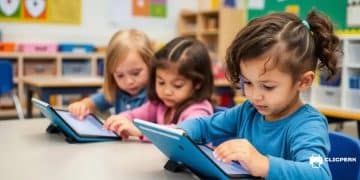Augmented Reality in education: Transform your learning experience

Anúncios
Augmented reality in education enhances student engagement and understanding by providing interactive and immersive learning experiences, despite challenges like cost and the need for teacher training.
Augmented reality in education is reshaping how students learn by providing immersive experiences that engage their curiosity. Have you ever wondered how technology can make learning more fun and effective? Let’s dive into this fascinating world.
Anúncios
Understanding augmented reality in education
In today’s digital age, understanding augmented reality in education is becoming essential. This technology enhances the way we learn, merging the physical world with digital information. By adding layers of interactive content, it transforms traditional lessons into engaging experiences.
What is Augmented Reality?
Augmented reality (AR) overlays digital content in the real world through devices like smartphones or AR glasses. Students can interact with 3D models, videos, and other multimedia elements that complement their curriculum.
Key Features of Augmented Reality in Education
- Interactive Learning: Students actively engage with materials rather than passively memorizing facts.
- Visual Learning: Information comes alive through visual representations, aiding comprehension.
- Enhanced Collaboration: Students can work together on AR projects, fostering teamwork and communication.
- Accessible Resources: Educational content can be accessed anytime, anywhere, accommodating different learning styles.
In addition, using augmented reality makes learning more immersive. Imagine a history class where students can explore ancient ruins through their devices. This experience not only captivates their attention but also deepens their understanding of historical contexts.
Anúncios
Moreover, AR can adapt to various learning environments. For instance, in a science class, students can visualize complex processes like photosynthesis or human anatomy through interactive 3D models. This practical application of knowledge fosters a deeper appreciation for the subject.
As augmented reality continues to evolve, educators can harness its potential to create rich, transformative learning experiences. Its integration into the classroom not only prepares students for future technological advancements but also inspires curiosity in their studies.
Benefits of augmented reality for students
The benefits of augmented reality for students are making waves in education. This innovative technology enhances learning experiences, catering to various learning styles and needs. With AR, students can engage more deeply, making education both fun and effective.
Enhanced Engagement
Augmented reality captures students’ attention like never before. When lessons feel alive with interactive elements, students become more focused and eager to learn. This increased engagement leads to better retention of information.
Real-World Applications
- Hands-On Learning: Students can experiment with virtual objects in real-time, allowing them to see practical applications of theories.
- Visualization: Complex concepts, like scientific phenomena, become easier to understand through visual representation.
- Immediate Feedback: AR applications can provide real-time assessments, helping students understand their mistakes and learn from them.
- Accessibility: Students with different learning abilities can benefit from personalized content tailored to their unique needs.
Moreover, using augmented reality encourages collaboration. Students can work together, discussing and solving problems in a virtual environment. This teamwork nurtures social skills and builds a supportive learning community.
Additionally, AR fosters creativity. When students create their own AR projects, they use imagination alongside technology. This combination stimulates critical thinking and innovation.
Importantly, augmented reality adapts to various subjects, whether it’s exploring the solar system in science or understanding historical events in social studies. This versatility ensures that it can enhance the learning experience in many areas.
How teachers can integrate augmented reality

Teachers can effectively integrate augmented reality into their classrooms, enhancing the learning process for students. By adopting this technology, educators can transform traditional lessons into interactive experiences that engage and inspire.
Start With the Right Tools
Using AR applications designed for education is the first step. Many apps are available that cater to various subjects. For example, teachers can choose tools that align with their curriculum, allowing students to explore topics in depth.
Develop Engaging Lessons
- Create Interactive Content: Teachers can develop engaging lessons that incorporate AR, such as virtual field trips or interactive science labs.
- Encourage Student Participation: Get students involved by allowing them to create their own AR content, which boosts creativity and fosters ownership of their learning.
- Utilize AR for Assessments: Implement AR in assessments to provide a unique way for students to demonstrate their understanding of topics.
- Incorporate Storytelling: Combine AR with storytelling to captivate students’ imaginations, making lessons memorable.
Collaboration is another benefit of incorporating augmented reality in classrooms. Teachers can encourage students to work together on projects, promoting teamwork and communication skills. For instance, students collaborating on an AR project can share ideas and learn from each other.
Additionally, teachers can gather feedback from students to assess their experiences with AR. Understanding what works or what might need adjustment is essential for improvement. Regular feedback helps tailor the lessons to meet the students’ needs.
Training and professional development are also key. Educators should seek opportunities to learn more about using AR effectively. This can include workshops, online courses, or collaborating with other teachers who have experience in this field.
Examples of augmented reality applications
There are numerous examples of augmented reality applications that showcase how this technology can enhance various fields. From education to healthcare, AR is transforming the way we engage with information and our surroundings.
Educational Applications
In the classroom, AR apps allow students to explore complex subjects in an interactive way. For instance, students can use AR to examine the solar system, viewing 3D models of planets and their orbits. Such experiences make learning more engaging and memorable.
Healthcare Innovations
Another exciting application of augmented reality is in healthcare. Surgeons can utilize AR technology during procedures to overlay vital information and 3D models on a patient’s body. This enhances precision and helps in visualizing complex anatomy.
Gaming and Entertainment
- Pokémon GO: This popular mobile game encourages players to explore the real world while catching virtual creatures.
- Ingress: Another AR game that fosters teamwork and strategy while players interact with real locations.
- AR Apps for Storytelling: Some applications create immersive stories, allowing users to experience tales in a 3D environment.
- Virtual Concerts: Events can utilize AR to provide a unique experience, combining real-life performances with virtual elements.
Retail is also benefiting from AR applications. Stores can create AR experiences where customers can visualize how furniture looks in their homes or try on clothes virtually. This interactive shopping experience makes it easier for customers to make decisions.
Moreover, augmented reality is finding its way into tourism. Travelers can use AR apps to learn about historical landmarks by simply pointing their devices at them. Such applications provide insightful information, enriching the travel experience.
As technology continues to evolve, we can expect even more innovative applications for augmented reality across various sectors, improving efficiency, engagement, and understanding.
Challenges of implementing augmented reality
Implementing augmented reality in education comes with several challenges that institutions must navigate. While the benefits are clearly promising, addressing these obstacles is crucial for successful integration.
Cost of Technology
One of the main challenges is the cost associated with acquiring AR technology. Devices such as AR headsets and tablets can be expensive, not to mention the software that needs to be developed or purchased. Schools often face budget constraints that limit their ability to invest in such technologies.
Training and Support
Another significant hurdle is the need for training teachers and staff. Without proper support and training, educators may feel overwhelmed or unsure about how to effectively use augmented reality in their lessons. Continuous professional development is essential to ensure that teachers are comfortable and skilled in using AR tools.
Technical Issues
- Infrastructure Requirements: Schools need strong Wi-Fi and reliable devices to support AR applications. Inadequate infrastructure can lead to frustrating experiences.
- Software Compatibility: Ensuring that AR software works seamlessly with existing systems can be a challenge. Technical issues can arise, leading to interruptions in learning.
- User Experience: If the AR experience is not user-friendly, students may become disengaged rather than excited about learning.
Moreover, there is the challenge of curriculum integration. Teachers may struggle to incorporate AR effectively into their existing lesson plans. It requires careful planning and creativity to align AR experiences with learning objectives.
Lastly, not all students may have equal access to the technology necessary for AR. This digital divide can create disparities in learning opportunities. Educators must find ways to ensure that all students can benefit from AR experiences, regardless of their circumstances.
augmented reality offers exciting possibilities for education, transforming how students learn and interact with information. However, challenges like cost, training, and technical issues must be addressed to make AR effective in classrooms. Overcoming these obstacles will ensure that all students can benefit from this innovative technology, leading to more engaging and interactive learning experiences. As we continue to explore AR’s potential, educators must stay informed and adapt to ensure success in their teaching methods.
FAQ – Frequently Asked Questions about Augmented Reality in Education
What are the main benefits of using augmented reality in classrooms?
Using augmented reality in classrooms enhances engagement, allows for interactive learning, and provides visual representations of complex concepts.
What challenges do schools face when implementing AR?
Schools often face challenges such as high costs for technology, need for teacher training, technical issues with infrastructure, and ensuring equal access for all students.
How can teachers start using AR in their lessons?
Teachers can start by selecting appropriate AR applications, planning engaging lessons, and integrating AR content with existing curricula.
Are there specific AR applications recommended for education?
Yes, applications like Google Expeditions, Merge Cube, and Quiver are popular for providing engaging AR experiences in educational settings.





